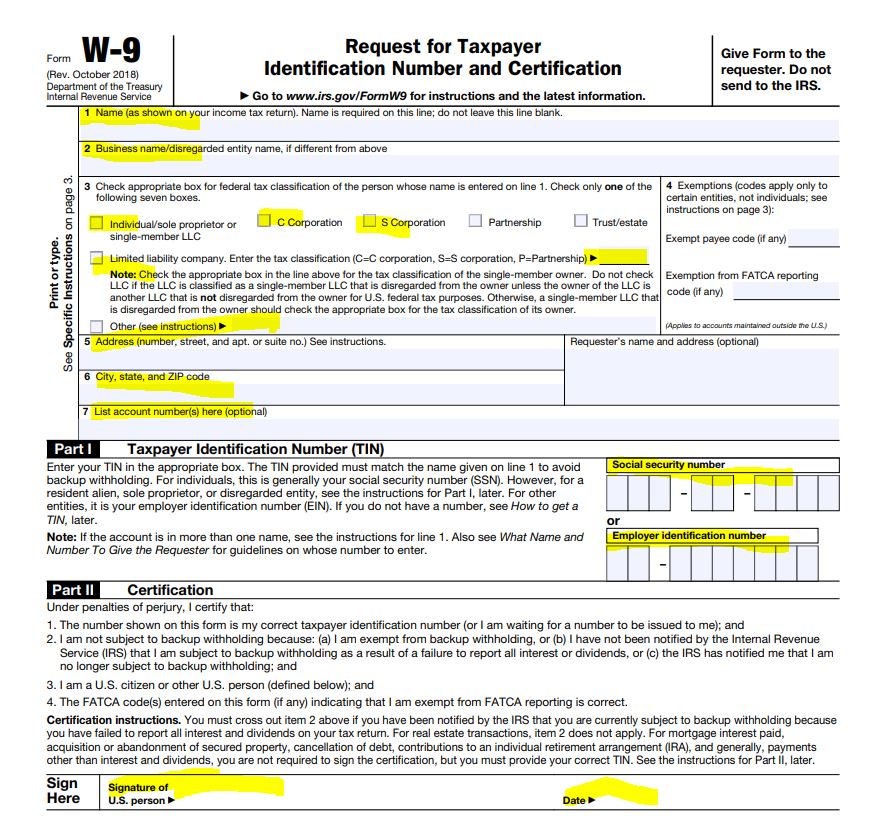Many businesses hire employees for short-term projects. Business relationships with independent contractors have become more likely during the pandemic. More people are looking for quick work and small businesses can benefit from short-term commitments. Independent contractors often work with numerous companies at the same time.
But what happens at the end of the year and it’s time to complete business taxes? Your full-time employees will get W-2s. Independent contractors get Form 1099. To complete the 1099, you’ll also need to know how the Form W-9 works.
What is a Form 1099?
1099 is the tax form for independent contractors. It’s the form a business uses to report income paid to workers who are not on the payroll, whether they are full-time or part-time employees. If you pay a freelancer, self-employed individual, sole proprietor for services, or an independent contractor, then you will need to file a form 1099 with the IRS. A copy of the Form 1099 you filed with the IRS should be given to the independent contractor. When a freelancer or independent contractor receives a 1099, they must report that income on their tax returns.
What is a Form W-9?
The IRS Form W-9 is filled out by the contractor. It provides their legal name, address, Social Security Number (SSN), or taxpayer identification number (TIN) to the business. Most employers ask for a W-9 to be filled out upon hiring a contractor. A freelancer should also offer to fill out a W-9 for each of their clients. In most cases, the information on a W-9 doesn’t change, so it’s practical to complete numerous forms so they are on hand and easy for an independent contractor to share.
Do you need a W-9 to process the 1099?
An employer doesn’t necessarily have to have a W-9 from independent contractors in order to provide them with a 1099-MISC. As long as an employee has access to a contractor or freelancer’s Social Security number or taxpayer ID number, they can issue a Form 1099. However, it is advisable to obtain a W-9 that contains either the SSN or TIN for each contractor. Having all the proper forms can help protect employers from penalties for providing false information to the IRS. Please note that it is the independent contractor who is liable for providing the correct information on the Form W-9.

Image by SnapwireSnaps from Pixabay
How to fill out a W-9 Form?
Below is the instruction how subcontractors and freelancers need to fill out the W-9 form, sign and provide to the payee.
Line 1 – Name
This line must not be left blank. If the the freelancer (subcontractor) is providing service under his or her name, full name should be entered accurately as individual. if the service is provided under a legal entity (LLC or Corporation) company’s legal name. The name should match the name on the tax return.
Line 2 – Business name
If you have a business name, trade name, DBA (Doing Business As) name, or disregarded entity name, fill it in here. If you do not have a business, you can leave this line blank.
Line 3 – Federal tax classification
This section defines how you, the independent contractor, are classified when it comes to federal taxes. You will check the first box if you are filing as an individual, sole proprietor, or single-member limited liability company (LLC) owned by an individual and disregarded for U.S. federal tax purposes.
The other boxes correspond to C corporation, S corporation, Partnership, and Trust/estate businesses.
Line 4 – Exemptions
You do not need to fill in this section as an individual. Only certain businesses or entities with any reason for exemption need to fill out these spaces. If this applies to you, you’ll need to provide a number or letter code that indicates that reason.
Lines 5 & 6 – Address, city, state, and ZIP code
Line 5 requires the address (number, street, and apartment or suite number) where your employer will mail your information returns. The following line, Line 6, leaves a space for you to enter the city, state, and ZIP code of this address.
Line 7 – Account number(s)
This is an optional line where you can fill in any account numbers your employer may need. Most individuals can leave this blank.
Part I – Taxpayer Identification Number (TIN)
You have two options in this section. You can enter either your Social Security number (SSN) or your employer identification number (EIN). Typically, you provide your SSN if you file as an individual or single-member LLC. Use your EIN if you file as a multi-member LLC classified as a corporation or partnership. If you are a sole proprietor, you could use either number, but your SSN is preferable.
If you are a resident alien and you are not eligible for an SSN, you should use your IRS individual taxpayer identification number (ITIN).
Part II – Certification
It is important W-9 form to be signed by appropriate person and dated before submitting to the employer. If the freelancer or contractor who filled out the form is an individual, he or she must sign the form and write the date. However, if the contractor is a company, owner of the company should sign the form.
 Who gets a W-9?
Who gets a W-9?
Independent contractors should file a Form W-9 with each of their employers or clients. However, the W-9 doesn’t have to be filed with the IRS. Each client should give the freelancer or contractor a Form 1099. They will use Form 1099 when filing taxes as a freelancer or contractor. An employer will need to file each Form 1099 with their state tax authority and the IRS.
There are a few exceptions to filing requirements. Employers are not required to complete and file a Form 1099 for a freelancer or independent contractor who was paid less than $600 in any of these categories:
- Rent
- Prizes and awards
- Payments to an attorney
- Payments for healthcare
- Proceeds from crop insurance
- Payment for fishing boat proceeds
- Payments in cash for purchasing aquatic life
- Cash paid by national principal contracts to individual taxpayers, an estate, or partnerships
- Miscellaneous income payments such as non-employee income for provided services
It’s important to note that a Form 1099 is only required if your payments to a contractor totaled $600 or more for the year. The total amount is for actual amounts paid, not accrued. For example, if you are paying a contractor a lump sum for a huge project that spans two years, you’ll only report it on the year the payment is made.

Image by googlerankfaster from Pixabay
Independent Contractor vs Regular Employee
Businesses often try to save money by using independent contractors instead of full-time employees. Employers do not have to pay payroll taxes or provide benefits for freelance or contract work. An independent contractor may perform services for your company, but they are not bound to the same requirements as your full-time employees. An independent contractor is responsible for putting aside some of their earnings to pay income tax. They are also responsible for their own retirement, health insurance, and other plans that are typically considered full-time employee benefits.
How to File Form 1099 with the IRS
As an employer, you will need to purchase 1099s directly from the IRS. You can also obtain them from your accounting software company. There should be five copies. One goes to the federal government, one goes to your state tax department, two go to the contractor or freelancer and one is to keep for your business files.
1099 is due to the IRS and contractors by February 1 of every year. 1099s cannot be scanned but can be filed online with the IRS if your accounting software can create the correct form. It’s often easier to mail all your Form 1099s with Form 1096. Form 1096 is just a summary of all the 1099s you are filing.


 Who gets a W-9?
Who gets a W-9?

